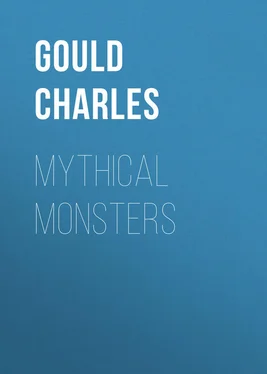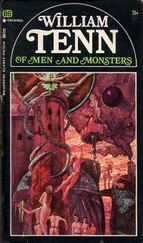Charles Gould - Mythical Monsters
Здесь есть возможность читать онлайн «Charles Gould - Mythical Monsters» — ознакомительный отрывок электронной книги совершенно бесплатно, а после прочтения отрывка купить полную версию. В некоторых случаях можно слушать аудио, скачать через торрент в формате fb2 и присутствует краткое содержание. Жанр: Мифы. Легенды. Эпос, Природа и животные, foreign_antique, foreign_prose, на английском языке. Описание произведения, (предисловие) а так же отзывы посетителей доступны на портале библиотеки ЛибКат.
- Название:Mythical Monsters
- Автор:
- Жанр:
- Год:неизвестен
- ISBN:нет данных
- Рейтинг книги:5 / 5. Голосов: 1
-
Избранное:Добавить в избранное
- Отзывы:
-
Ваша оценка:
- 100
- 1
- 2
- 3
- 4
- 5
Mythical Monsters: краткое содержание, описание и аннотация
Предлагаем к чтению аннотацию, описание, краткое содержание или предисловие (зависит от того, что написал сам автор книги «Mythical Monsters»). Если вы не нашли необходимую информацию о книге — напишите в комментариях, мы постараемся отыскать её.
Mythical Monsters — читать онлайн ознакомительный отрывок
Ниже представлен текст книги, разбитый по страницам. Система сохранения места последней прочитанной страницы, позволяет с удобством читать онлайн бесплатно книгу «Mythical Monsters», без необходимости каждый раз заново искать на чём Вы остановились. Поставьте закладку, и сможете в любой момент перейти на страницу, на которой закончили чтение.
Интервал:
Закладка:
It has been identified by Mr. Busk among the associated mammalian bones of the Brixham cave. Its remains are very abundant in the bone deposit of the Trou de Sureau in Belgium, and in the cavern of Goyet, which it tenanted alternately with the lion and hyæna, and, like them, appears to have preyed on man and the larger mammalia.
Mr. Prestwich has obtained it in low-level deposits of river gravels in the valleys of the north of France and south of England, and it has been obtained from the Löss, a loamy, usually unstratified deposit, which is extensively distributed over central Europe, in the valleys of the Rhine, Rhone, Danube, and other great rivers. This deposit is considered by Mr. Prestwich to be equivalent to other high-level gravels of the Pleistocene period.
The Mastodon. – The generic title Mastodon has been applied to a number of species allied to the elephants, but distinguished from them by a peculiar structure of the molar teeth; these are rectangular, and in their upper surfaces exhibit a number of great conical tuberosities with rounded points disposed in pairs, to the number of four or five, according to the species; whereas in the elephants they are broad and uniform, and regularly marked with furrows of large curvature. The mastodons, in addition to large tusks in the premaxillæ, like those of the elephant, had also in most instances, a pair of shorter ones in the mandible.
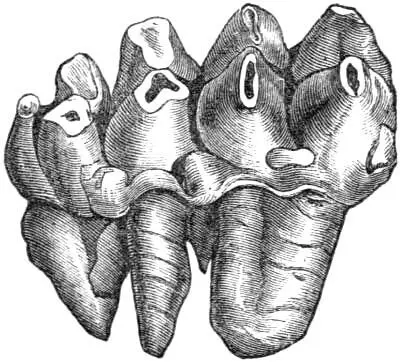
Fig. 11. – Mastodon’s Tooth (worn). ( After Figuier. )
Cuvier established the name Mastodon, 51or teat-like toothed animals, for the gigantic species from America which Buffon had already described under the name of the animal or elephant of the Ohio.
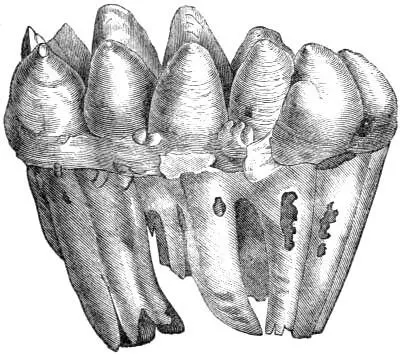
Fig. 12. – Mastodon’s Tooth. ( After Figuier. )
The form first appears in the Upper Miocene of Europe, five species being known, two of them from Pikermi, near Athens, and one, M. angustidens , from the Miocene beds of Malta. Mastodon remains have also been found in the beds of the Sivalik hills, and four species of mastodon in all are known to have ranged over India during those periods.
In Pliocene deposits we have abundant remains of M. arvernensis , and M. longirostris from the Val d’Arno in Italy, and the M. Borsoni from central France.
The M. arvernensis may be considered as a characteristic Pliocene species in Italy, France, and Europe generally. In Britain it occurs in the Norwich Crag and the Red Crag of Suffolk.
Species of mastodon occur in the Pliocene of La Plata, and of the temperate regions of South America; on the Pampas, and in the Andes of Chili.
The Mastodon mirificus of Leidy is the earliest known species in America; this occurs in Pliocene deposits on the Niobrara and the Loup fork, west of the Mississippi.
The remains of the Mastodon americanus of Cuvier occur abundantly in the Post Pliocene deposits throughout the United States, but more especially in the northern half; they are also found in Canada and Nova Scotia.
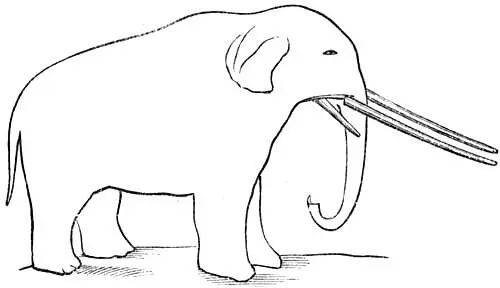
Fig. 13. – The Mastodon.
Perfect skeletons are occasionally procured from marshes, where the animals had become mired. In life this species appears to have measured from twelve to thirteen feet in height and twenty-four to twenty-five feet in length, including seven feet for the tusks. Undigested food found with its remains show that it lived partly on spruce and fir-trees. A distinct species characterised the Quaternary deposits of South America.
The Irish Elk. – The species ( Megaceros hibernicus ), commonly but erroneously called the Irish Elk, was, as professor Owen 52has pointed out, a true deer, whose place is between the fallow and reindeer.
Though now extinct, it survived the Palæolithic period, and may possibly have existed down to historic times. Mr. Gosse adduces some very strong testimony on this point, and is of opinion that its extinction cannot have taken place more than a thousand years ago.
It had a flattened and expanded form of antler, with peculiarities unknown among existing deer, and was, in comparison with these, of gigantic size; the height to the summit of the antlers being from ten to eleven feet in the largest individuals, and the span of the antlers, in one case, over twelve feet.
Although its remains have been found most abundantly in Ireland, it was widely distributed over Britain and middle Europe. It has been found in peat swamps, lacustrine marls, bone caverns, fen deposits, and the Cornish gravels. It has been obtained from the cavern of Goyet in Belgium, and from the burial-place at Aurignac, in the department of the Haute Garonne. Its known range in time is from the early part of the Glacial period down to, possibly, historic periods.
The Cave-Hyæna. — Hyæna spelæa of Goldfuss – is, like the cave-bear, characteristic of Europe during the Palæolithic age. It has been found in numerous caves in Britain, such as Kent’s Hole, the Brixham cave, and one near Wells in Somersetshire, explored by Dawkins in 1859; in all of these the remains are associated with those of man, or with his implements. This species is closely related to the H. crocuta of Zimm, at present existing in South Africa, and is by some geologists considered identical with it. It is, however, larger.
It appears to have to some extent replaced the cave-bear in Britain; we are also, doubtless, greatly indebted to it for some of the extensive collections of bones in caverns, resulting from the carcases which it had dragged thither, and imperfectly destroyed.
In a cave at Kirkdale, in the vale of Pickering, the bones of about three hundred individuals – hyænas – were found mingled with the remains of the mammoth, bear, rhinoceros, deer, cave-lion, brown bear, horse, hare, and other species. Mr. Dawkins, 53in describing it, says: “The pack of hyænas fell upon reindeer in the winter, and at other times on horses and bisons, and were able to master the hippopotamus, the lion, the slender-nosed rhinoceros, or the straight-tusked elephant, and to carry their bones to their den, where they were found by Dr. Buckland. The hyænas also inhabiting the ‘Dukeries,’ dragged back to their dens fragments of lion.”
Notable Quaternary forms (now extinct) on the American continent are the gigantic sloth-like animals Megatherium , which reached eighteen feet in length, and Mylodon , one species of which ( M. robustus ) was eleven feet in length; Armadillos, such as Glyptodon , with a total length of nine feet; Chlamydotherium , as big as a rhinoceros; and Pachytherium , equalling an ox.
In Australia we find marsupial forms as at the present day; but they were gigantic in comparison with the latter. As for example, the Diprotodon , which equalled in size a hippopotamus, and the Nototherium , as large as a bullock.
I may mention a few other species, the remains of which are associated with some of those commented on in the last few pages; but which, as they have undoubtedly continued in existence down to the present period, are external to the present portion of my argument, and are either treated of elsewhere, or need only to be referred to in a few words.
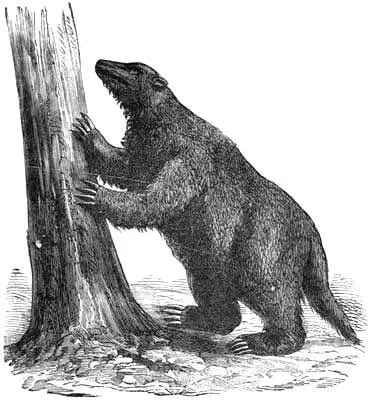
Fig. 14. – Mylodon robustus. ( After Figuier. )
Читать дальшеИнтервал:
Закладка:
Похожие книги на «Mythical Monsters»
Представляем Вашему вниманию похожие книги на «Mythical Monsters» списком для выбора. Мы отобрали схожую по названию и смыслу литературу в надежде предоставить читателям больше вариантов отыскать новые, интересные, ещё непрочитанные произведения.
Обсуждение, отзывы о книге «Mythical Monsters» и просто собственные мнения читателей. Оставьте ваши комментарии, напишите, что Вы думаете о произведении, его смысле или главных героях. Укажите что конкретно понравилось, а что нет, и почему Вы так считаете.
